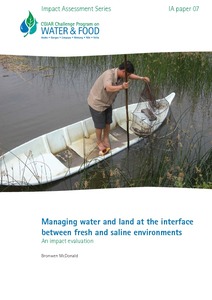Resource information
The Bac Lieu Province in the Mekong Delta is part
of the Cà Mau Peninsula and is an important foodgrowing
area in Viet Nam. It has a population of
830,000 with approximately 116,000 farming families
living on small parcels of land producing a range of
commodities for food security and the export market.
These farmers and aquaculturalists1 (together called
producers in this report) are highly dependent on
accessing the right quality water, fresh or saline or
both, at the right time to grow their crops or raise
their shrimp, crabs or fish. Water is delivered through
an extensive network of canals and the intrusion of
saline water into the area can be controlled on the
southeastern side through the operation of sluice gates,
a major investment in infrastructure undertaken by
the Central Government of Viet Nam.
In the early 2000s, there were conflicts over water
use as shrimp aquaculturalists in particular began to
see their supply of saline water being compromised.
Also, many producers were living in poverty and in
some areas inappropriate land use was leading to
unsustainable futures. This project completed in 2007
and built on the work of two preceding projects2
is helping change that situation. What’s more, this
impact will continue to grow as the outputs are more
widely applied.
1 The term ‘aquaculturalist’ is used to differentiate people who
‘farm’ fish from those who catch fish in the wild.
2 The two projects are Accelerating Poverty Elimination
through Sustainable Resource Management funded by DFID
and Increasing Water Productivity by Managing Land-water
Interface: Effective Water Control for Solving Conflicts
among Agriculture-Fisheries-Aquaculture in Coastal Zones
funded by CGIAR.
With inputs including (i) approximately US$679,000
over 3 years, 86% from the Challenge Program on
Water and Food (CPWF), (ii) support from CPWF
in training in impact pathway analysis and for faceto-
face meetings between the Bangladesh and Viet
Nam components of this project to share experiences
and lessons, (iii) an existing water management model
ready for further development, (iv) the scientific
knowledge of many local and international experts,
(v) the experience of a wide range of partners in water
management and production systems, (vi) the active
participation of the provincial and local governments,
(vii) the agreement of producers to provide their
businesses as laboratories, (viii) the agreements of
other producers to provide their farms as control
farms with a likely opportunity cost, and (ix) the
participation of producer groups who shared their
experiences and insights, this project:
• produced an improved Vietnamese River
Systems and Plains (VRSAP) model that now
contributes to improved sluice gate operations
to better meet producers’ water needs;
• used the model and other data to contribute
to the development of the Bac Lieu People’s
Committee’s Land Use Policy, which
recognizes the benefits of diversification and the
role of saline water in farming; and
• developed and evaluated a successful
participatory extension approach that assists
producers select appropriate technologies (and
reject others) based on on-farm demonstration
and experimentation.
On average, the demonstration site farms involved
in the project made approximately US$250/ha/
year more than the controls (extrapolated from Ni
et al. 2007). The producers interviewed believed the
financial gain made a significant difference to their


